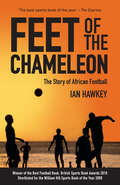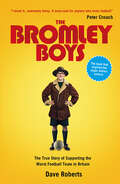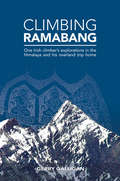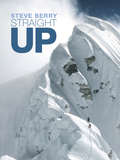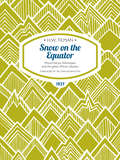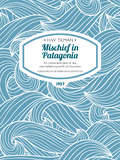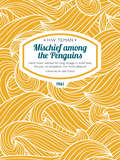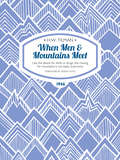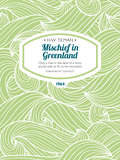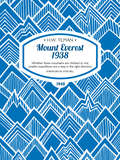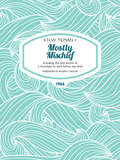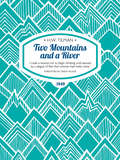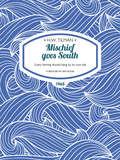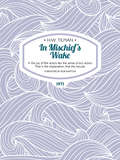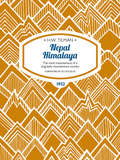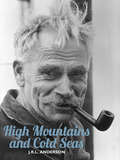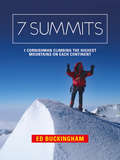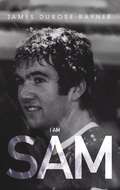- Table View
- List View
The Hardest Test (Quick Reads)
by Scott QuinnellScott Quinnell’s book is called The Hardest Test. It is the story of how he became a successful rugby player, in spite of having to fight against learning difficulties at school. When he retired in 2005 he continued his battle with dyslexia in order to change both his and his children’s lives for ever.Rugby player Scott Quinnell played for the Llanelli Scarlets and played for his country, Wales, fifty-two times. He was also a British lion. He reached the very top of his sport before he retired in 2005. He is now one of the most recognisable faces in world rugby.
Feet of the Chameleon: The Story Of African Football
by Ian HawkeyWinner of the Best Football Book at the British Sports Book Awards and shortlisted for the William Hill Sports Book of The Year 2009 'Written with warmth and understanding, the book for which African football has been crying out.' FourFourTwo
The Bromley Boys: The True Story Of Supporting The Worst Football Club In Britain
by Dave RobertsThe book that inspired the major motion picture 'I loved it … extremely funny. A must-read for anyone who loves football.' Peter Crouch
Vive le Tour!: Wiggo, And The Amazing Tales Of The Tour De France
by Nick BrownleeThe Observer, July 1, 2007 "A quirky and inventive collection of history, statistics and random trivia, Brownlee's book would be perfect for whipping out of the back pocket of your cycling jersey to settle arguments or impress your friends."
How to Take a Penalty
by Rob EastawayThe Hidden Mathematics of Sport takes a novel and intriguing look at sport, byexploring the mathematics behind the action. Discover the best tactics for takinga penalty, the pros and cons of being a consistent golfer, the surprising linkbetween boxing and figure skating, the unusual location of England's earliest'football' game (in a parish church), and the formula for always winning a gameof tennis. Whatever your sporting interests, you will find plenty to absorb andamuse you in this entertaining and unique book – and maybe you will even findsome new strategies for beating the odds.
Climbing Ramabang: One Irish climber's explorations in the Himalaya and his overland trip home
by Gerry GalliganGerry Galligan's first book is a bold and expansive travel diary recounting his assembling of a small team of Irish mountaineers and their attempts on unclimbed mountains and unexplored valleys in the remote corners of the Indian Himalaya. Getting there, the team see the hardships of the sub-continent, while in the mountains they experience storms, dangers and failure before ultimately, success and contentment. But it is when Gerry returns to the mountains alone and his subsequent experiences overlanding across Asia and Europe back to Ireland that we start to get a glimpse of the big, wide world out there. A world of temples, festivals, holy cows, Kalashnikovs, donkey herders, corruption, opportunists, stoners and sages. Gerry gives us an insight into the day-to-day lives of mountain peoples, the dysfunctional functionality of India. He finds charm and tolerance in Pakistan and a surprising openness in today's Iran. We travel across rural Turkey and work our way back to the efficient and affluent West, where right on cue Gerry meets his first breakdown on a German train. Climbing Ramabang; One man's understanding of mountains, myth and mayhem.
Straight Up: Himalayan Tales of the Unexpected
by Steve BerryBorn in the foothills close to the Himalaya Steve Berry had from an early age an urge to become a traveller, an adventurer, an explorer, and until the age of thirty-eight years he tried hard to satisfy two opposing forces. Half of him wanted to find a satisfactory career path while the other half wanted to be free and specifically explore the Himalaya. In the end he found a compromise to satisfy both needs. In 1987 with his climbing friend Steve Bell he founded Himalayan Kingdoms, a travel company specialising in trekking and expedition holidays. This book is a collection of stories from his early expeditions to the Himalaya prior to 1987. There are tales of encounters with bears, escapes from avalanches, summit successes and failures, love stories mystical connections, Himalayan storms, near death accidents, raw travel across the Indian sub-continent, and grapples with bureaucracy. It is told warts and all. It starts with tales of youthful naivety in the mountains of Himachal Pradesh, progresses to what Steve describes as his best ever adventure, the first British ascent of Nun, 7,135m/23,410ft, in Kashmir, and finishes with the truth of what happened on the failed attempt to climb Bhutan's highest peak, Gangkar Punsum, 7550m/24,770ft. Of Straight Up Steve says: 'I just really wanted people to enjoy reading of our adventures the way they were.'
Snow on the Equator: Mount Kenya, Kilimanjaro and the great African odyssey (H.W. Tilman: The Collected Edition #1)
by H.W. Tilman‘To those who went to the War straight from school and survived it, the problem of what to do afterwards was peculiarly difficult.’For H.W. ‘Bill’ Tilman, the solution lay in Africa: in gold prospecting, mountaineering and a 3,000-mile bicycle ride across the continent. Tilman was one of the greatest adventurers of his time, a pioneering climber and sailor who held exploration above all else. He made first ascents throughout the Himalaya, attempted Mount Everest, and sailed into the Arctic Circle. For Tilman, the goal was always to explore, to see new places, to discover rather than conquer.First published in 1937, Snow on the Equator chronicles Tilman’s early adventures; his transition from East African coffee planter to famed mountaineer. After World War I, Tilman left for Africa, where he grew coffee, prospected for gold and met Eric Shipton, the two beginning their famed mountaineering partnership, traversing Mount Kenya and climbing Kilimanjaro and Ruwenzori. Tilman eventually left Africa in typically adventurous style via a 3,000-mile solo bicycle ride across the continent—all recounted here in splendidly funny style.Tilman is one of the greatest of all travel writers. His books are well-informed and keenly observed, concerned with places and people as much as summits and achievements. They are full of humour and anecdotes and are frequently hilarious. He is part of the great British tradition of comic writing and there is nobody else quite like him.
Mischief in Patagonia: An intolerable deal of sea, one halfpennyworth of mountain (H.W. Tilman: The Collected Edition)
by H.W. Tilman'So I began thinking again of those two white blanks on the map, of penguins and humming birds, of the pampas and of gauchos, in short, of Patagonia, a place where, one was told, the natives’ heads steam when they eat marmalade.'So responded H. W. ‘Bill’ Tilman to his own realisation that the Himalaya were too high for a mountaineer now well into his fifties. He would trade extremes of altitude for the romance of the sea with, at his journey’s end, mountains and glaciers at a smaller scale; and the less explored they were, the better he would like it. Within a couple of years he had progressed from sailing a 14-foot dinghy to his own 45-foot pilot cutter Mischief, readied for her deep-sea voyaging, and recruited a crew for his most ambitious of private expeditions.Well past her prime, Mischief carried Tilman, along with an ex-dairy farmer, two army officers and a retired civil servant, safely the length of the North and South Atlantic oceans, and through the notoriously difficult Magellan Strait, against strong prevailing winds, to their icy landfall in the far south of Chile.The shore party spent six weeks crossing the Patagonian ice cap, in both directions, returning to find that their vessel had suffered a broken propeller. Edging north under sail only, Mischief put into Valparaiso for repairs, and finally made it home to Lymington via the Panama Canal, for a total of 20,000 nautical miles sailed, in addition to a major exploration ‘first’ all here related with the skipper’s characteristic modesty and bone-dry humour, and many photographs.
The Ascent of Nanda Devi: I believe we so far forgot ourselves as to shake hands on it (H.W. Tilman: The Collected Edition #2)
by H.W. TilmanIn 1934, after fifty years of trying, mountaineers finally gained access to the Nanda Devi Sanctuary in the Garhwal Himalaya.Two years later an expedition led by H.W. Tilman reached the summit of Nanda Devi. At over 25,000 feet, it was the highest mountain to be climbed until 1950.The Ascent of Nanda Devi, Tilman’s account of the climb, has been widely hailed as a classic. Keenly observed, well informed and at times hilariously funny, it is as close to a ‘conventional’ mountaineering account as Tilman could manage. Beginning with the history of the mountain (‘there was none’) and the expedition’s arrival in India, Tilman recounts the build-up and approach to the climb.Writing in his characteristic dry style, he tells how Sherpas are hired, provisions are gathered (including ‘a mouth-blistering sauce containing 100 per cent chillies’) and the climbers head into the hills, towards Nanda Devi. Superbly parodied in The Ascent of Rum Doodle by W.E. Bowman, The Ascent of Nanda Devi was among the earliest accounts of a climbing expedition to be published. Much imitated but rarely matched, it remains one of the best.
Mischief among the Penguins: Hand (man) wanted for long voyage in small boat. No pay, no prospects, not much pleasure. (H.W. Tilman: The Collected Edition)
by H.W. Tilman‘Hand (man) wanted for long voyage in small boat. No pay, no prospects, not much pleasure.’So read the crew notice placed in the personal column of The Times by H.W. ‘Bill’ Tilman in the spring of 1959. This approach to selecting volunteers for a year-long voyage of 20,000 miles brought mixed seafaring experience: ‘Osborne had crossed the Atlantic fifty-one times in the Queen Mary, playing double bass in the ship’s orchestra’.With unclimbed ice-capped peaks and anchorages that could at best be described as challenging, the Southern Ocean island groups of Crozet and Kerguelen provided obvious destinations for Tilman and his fifty-year-old wooden pilot cutter Mischief. His previous attempt to land in the Crozet Islands had been abandoned when their only means of landing was carried away by a severe storm in the Southern Ocean.Back at Lymington, a survey of the ship uncovered serious Teredo worm damage. Tilman, undeterred, sold his car to fund the rebuilding work and began planning his third sailing expedition to the southern hemisphere.Mischief among the Penguins (1961), Tilman’s account of landfalls on these tiny remote volcanic islands, bears testament to the development of his ocean navigation skills and seamanship. The accounts of the island anchorages, their snow-covered heights, geology and in particular the flora and fauna pay tribute to the varied interests and ingenuity of Mischief’s crew, not least after several months at sea when food supplies needed to be eked out. Tilman’s writing style, rich with informative and entertaining quotations, highlights the lessons learned with typical self-deprecating humour, while playing down the immensity of his achievements.
When Men & Mountains Meet: Like the desire for drink or drugs, the craving for mountains is not easily overcome (H.W. Tilman: The Collected Edition)
by H.W. Tilman‘We had climbed a mountain and crossed a pass; been wet, cold, hungry, frightened, and withal happy. One more Himalayan season was over. It was time to begin thinking of the next. “Strenuousness is the immortal path, sloth is the way of death.”’First published in 1946, the scope of H.W. ‘Bill’ Tilman’s When Men and Mountains Meet is broad, covering his disastrous expedition to the Assam Himalaya, a small exploratory trip into Sikkim, and then his wartime heroics.In the thirties, Assam was largely unknown and unexplored. It proved a challenging environment for Tilman’s party, the jungle leaving the men mosquito-bitten and suffering with tropical diseases, and thwarting their mountaineering success. Sikkim proved altogether more successful. Tilman, who is once again happy and healthy, enjoys some exploratory ice climbing and discovers Abominable Snowman tracks, particularly remarkable as the creature appeared to be wearing boots—‘there is no reason why he should not have picked up a discarded pair at the German Base Camp and put them to their obvious use'.And then, in 1939, war breaks out. With good humour and characteristic understatement we hear about Tilman’s remarkable Second World War. After digging gun pits on the Belgian border and in Iraq, he was dropped by parachute behind enemy lines to fight alongside Albanian and Italian partisans. Tilman was awarded the Distinguished Service Order for his efforts—and the keys to the city of Belluno, which he helped save from occupation and destruction.Tilman’s comments on the German approach to Himalayan climbing could equally be applied to his guerrilla warfare ethos. ‘They spent a lot of time and money and lost a lot of climbers and porters, through bad luck and more often through bad judgement.’ While elsewhere the war machine rumbled on, Tilman’s war was fast, exciting, lightweight and foolhardy—and makes for gripping reading.
Mischief in Greenland: Only a man in the devil of a hurry would wish to fly to his mountains (H.W. Tilman: The Collected Edition)
by H.W. Tilman‘Only a man in the devil of a hurry would wish to fly to his mountains, forgoing the lingering pleasure and mounting excitement of a slow, arduous approach under his own exertions.’H.W. ‘Bill’ Tilman’s mountain travel philosophy, rooted in Africa and the Himalaya and further developed in his early sailing adventures in the southern hemisphere, was honed to perfection with his discovery of Greenland as the perfect sailing destination. His Arctic voyages in the pilot cutter Mischief proved no less challenging than his earlier southern voyages. The shorter elapsed time made it rather easier to find a crew but the absence of warm tropical passages meant that similar levels of hardship were simply compressed into a shorter timescale.First published fifty years before political correctness became an accepted rule, Mischief in Greenland is a treasure trove of Tilman’s observational wit. In this account of his first two West Greenland voyages, he pulls no punches with regard to the occasional failings, leaving the reader to seek out and discover the numerous achievements of these voyages. The highlight of the second voyage was the identification, surveying and successful first ascent of Mount Raleigh, first observed on the eastern coast of Baffin Island by the Elizabethan explorer John Davis in 1585. For the many sailors and climbers who have since followed his lead and ventured north into those waters, Tilman provides much practical advice, whether from his own observations or those of Davis and the inimitable Captain Lecky. Tilman’s typical gift of understatement belies his position as one of the greatest explorers and adventurers of the twentieth century.
Mount Everest 1938: Whether these mountains are climbed or not, smaller expeditions are a step in the right direction (H.W. Tilman: The Collected Edition)
by H.W. Tilman‘Whether these mountains are climbed or not, smaller expeditions are a step in the right direction.’It’s 1938, the British have thrown everything they’ve got at Everest but they’ve still not reached the summit. War in Europe seems inevitable; the Empire is shrinking. Still reeling from failure in 1936, the British are granted one more permit by the Tibetans, one more chance to climb the mountain. Only limited resources are available, so can a small team be assembled and succeed where larger teams have failed?H.W. Tilman is the obvious choice to lead a select team made up of some of the greatest British mountaineers history has ever known, including Eric Shipton, Frank Smythe and Noel Odell. Indeed, Tilman favours this lightweight approach. He carries oxygen but doesn’t trust it or think it ethical to use it himself, and refuses to take luxuries on the expedition, although he does regret leaving a case of champagne behind for most of his time on the mountain.On the mountain, the team is cold, the weather very wintery. It is with amazing fortitude that they establish a camp six at all, thanks in part to a Sherpa going by the family name of Tensing. Tilman carries to the high camp, but exhausted he retreats, leaving Smythe and Shipton to settle in for the night. He records in his diary, ‘Frank and Eric going well—think they may do it.’ But the monsoon is fast approaching …In Mount Everest 1938, first published in 1948, Tilman writes that it is difficult to give the layman much idea of the actual difficulties of the last 2,000 feet of Everest. He returns to the high camp and, in exceptional style, they try for the ridge, the route to the summit and those immense difficulties of the few remaining feet.
Mostly Mischief: Including the first ascent of a mountain to start below sea level (H.W. Tilman: The Collected Edition)
by H.W. Tilman'However many times it has been done, the act of casting off the warps and letting go one’s last hold of the shore at the start of a voyage has about it something solemn and irrevocable, like marriage, for better or for worse.’Mostly Mischief’s ordinary title belies four more extraordinary voyages made by H.W. ‘Bill’ Tilman covering almost 25,000 miles in both Arctic and Antarctic waters.The first sees the pilot cutter Mischief retracing the steps of Elizabethan explorer John Davis to the eastern entrance to the Northwest Passage. Tilman and a companion land on the north coast and make the hazardous crossing of Bylot Island while the remainder of the crew make the eventful passage to the southern shore to recover the climbing party. Back in England, Tilman refuses to accept the condemnation of Mischief’s surveyor, undertaking costly repairs before heading back to sea for a first encounter with the East Greenland ice.Between June 1964 and September 1965, Tilman is at sea almost without a break. Two eventful voyages to East Greenland in Mischief provide the entertaining bookends to his account of the five-month voyage in the Southern Ocean as skipper of the schooner Patanela. Tilman had been hand-picked by the expedition leader as the navigator best able to land a team of Australian and New Zealand climbers and scientists on Heard Island, a tiny volcanic speck in the Furious Fifties devoid of safe anchorages and capped by an unclimbed glaciated peak. In a separate account of this successful voyage, Colin Putt describes the expedition as unique—the first ascent of a mountain to start below sea level.
Two Mountains and a River: I made a resolve not to begin climbing until assured by a plague of flies that summer had really come (H.W. Tilman: The Collected Edition)
by H.W. TilmanH.W. Tilman’s Two Mountains and a River picks up where Mount Everest 1938 left off. In this instalment of adventures, Tilman and two Swiss mountaineers set off for the Gilgit region of the Himalaya with the formidable objective of an attempt on the giant Rakaposhi (25,550 feet). However, this project was not to be fulfilled.Not one to be dispirited, Tilman and his various accomplices—including pioneering mountaineer and regular partner Eric Shipton—continue to trek and climb in locations across China, Pakistan, Afghanistan and other areas of Asia, including the Kukuay Glacier, Muztagh Ata, the source of the Oxus river, and Ishkashim, where the author was arrested on suspicion of being a spy …Two Mountains and a River brims with the definitive Tilman qualities— detailed observations and ever-present humour—that convey a strong appreciation of the adventures and mishaps he experiences along the way. With a new foreword from prominent trekker, climber and lecturer, Gerda Pauler, this classic mountaineering text maintains Tilman’s name as a unique and inquisitive explorer and raconteur.
Mischief goes South: Every herring should hang by its own tail (H.W. Tilman: The Collected Edition)
by H.W. Tilman‘No sea voyage can be dull for a man who has an eye for the ever-changing sea and sky, the waves, the wind and the way of a ship upon the water.’So observes H.W. ‘Bill’ Tilman in this account of two lengthy voyages in which dull intervals were few and far between.In 1966, after a succession of eventful and successful voyages in the high latitudes of the Arctic, Tilman and his pilot cutter Mischief head south again, this time with the Antarctic Peninsula, Smith Island and the unclimbed Mount Foster in their sights. Mischief goes South is an account of a voyage marred by tragedy and dogged by crew trouble from the start. Tilman gives ample insight into the difficulties associated with his selection of shipmates and his supervision of a crew, as he wryly notes, ‘to have four misfits in a crew of five is too many’.The second part of this volume contains the author’s account of a gruelling voyage south, an account left unwritten for ten years for lack of time and energy. Originally intended as an expedition to the remote Crozet Islands in the southern Indian Ocean, this 1957 voyage evolved into a circumnavigation of Africa, the unplanned consequence of a momentary lapse in attention by an inexperienced helmsman.The two voyages described in Mischief goes South covered 43,000 miles over twenty-five months spent at sea and, while neither was deemed successful, published together they give a fine insight into Tilman’s character.
China to Chitral: Mountains are the beginning and end of all scenery (H.W. Tilman: The Collected Edition)
by H.W. TilmanIn China to Chitral H.W. ‘Bill’ Tilman completes one of his great post-war journeys. He travels from Central China, crossing Sinkiang, the Gobi and Takla Makan Deserts, before escaping to a crumbling British Empire with a crossing of the Karakoram to the new nation of Pakistan.In 1951 there still persisted a legend that a vast mountain, higher than Everest, was to be found in the region, a good enough reason it seems for Tilman to traverse the land, ‘a land shut in on three sides by vast snow ranges whose glacial streams nourish the oases and upon whose slopes the yaks and camels graze side by side; where in their felt yorts the Kirghiz and Kazak live much as they did in the days of Genghis Khan, except now they no longer take a hand in the devastation of Europe’.Widely regarded as some of Tilman’s finest travel writing, China to Chitral is full of understatement and laconic humour, with descriptions of disastrous attempts on unclimbed mountains with Shipton, including Bogdo Ola—an extension of the mighty Tien Shan mountains—and the Chakar Aghil group near Kashgar on the old silk road. His command of the Chinese language—five words, all referring to food—proves less than helpful in his quest to find a decent meal: ‘fortunately, in China there are no ridiculous hygienic regulations on the sale of food’. Tilman also has several unnerving encounters with less-than-friendly tribesmen …Tilman starts proper in Lanchow where he describes with some regret that he is less a traveller and more a passenger on this great traverse of the central basin and rim of mountain ranges at Asia’s heart. But Tilman is one of our greatest ever travel writers, and we become a passenger to his adventurers.
In Mischief's Wake: In the joy of the actors lies the sense of any action. That is the explanation, that the excuse. (H.W. Tilman: The Collected Edition)
by H.W. Tilman‘I felt like one who had first betrayed and then deserted a stricken friend; a friend with whom for the past fourteen years I had spent more time at sea than on land, and who, when not at sea, had seldom been out of my thoughts.’The first of the three voyages described in In Mischief’s Wake gives H.W. ‘Bill’ Tilman’s account of the final voyage and loss of Mischief, the Bristol Channel pilot cutter in which he had sailed over 100,000 miles to high latitudes in both Arctic and Antarctic waters.Back home, refusing to accept defeat and going against the advice of his surveyor, he takes ownership of Sea Breeze, built in 1899; ‘a bit long in the tooth, but no more so, in fact a year less, than her prospective owner’. After extensive remedial work, his first attempt at departure had to be cut short when the crew ‘enjoyed a view of the Isle of Wight between two of the waterline planks’. After yet more expense, Sea Breeze made landfall in Iceland before heading north toward the East Greenland coast in good shape and well stocked with supplies. A mere forty miles from the entrance to Scoresby Sound, Tilman’s long-sought-after objective, ‘a polite mutiny’ forced him to abandon the voyage and head home.The following year, with a crew game for all challenges, a series of adventures on the west coast of Greenland gave Tilman a voyage he considered ‘certainly the happiest’, in a boat which was proving to be a worthy successor to his beloved Mischief.
Nepal Himalaya: The most mountainous of a singularly mountainous country. (H.W. Tilman: The Collected Edition)
by H.W. TilmanThroughout 1949 and 1950 H.W. ‘Bill’ Tilman mounted pioneering expeditions to Nepal and its Himalayan mountains, taking advantage of some of the first access to the country for Western travellers in the 20th century. Tilman and his party—including a certain Tenzing Norgay—trekked into the Kathmandu Valley and on to the Langtang region, where the highs and lows began.They first explored the Ganesh Himal, before moving on to the Jugal Himal and the following season embarking on an ambitious trip to Annapurna and Everest. Manaslu was their first objective, but left to ‘better men’, and Annapurna IV very nearly climbed instead but for bad weather which dogged the whole expedition. Needless to say, Tilman was leading some very lightweight expeditions into some seriously heavyweight mountains.After the Annapurna adventure Tilman headed to Everest with—among others—Dr Charles Houston. Approaching from the delights of Namche Bazaar, the party made progress up the flanks of Pumori to gaze as best they could into the Western Cwm, and at the South Col and South-East Ridge approach to the summit of Everest. His observations were both optimistic and pessimistic: ‘One cannot write off the south side as impossible until the approach from the head of the West Cwm to this remarkably airy col has been seen.’ But then of the West Cwm: ‘A trench overhung by these two tremendous walls might easily become a grave for any party which pitched its camp there.’Nepal Himalaya presents Tilman’s favourite sketches, encounters with endless yetis, trouble with the porters, his obsessive relationship with alcohol and issues with the food. And so Tilman departs Nepal for the last time proper with these retiring words: ‘If a man feels he is failing to achieve this stern standard he should perhaps withdraw from a field of such high endeavour as the Himalaya.’
Ice with Everything: In climbing mountains or sailing the seas one often has to settle for less than one hoped. (H.W. Tilman: The Collected Edition)
by H.W. Tilman‘For most men, as Epicurus has remarked, rest is stagnation and activity madness. Mad or not, the activity that I have been pursuing for the last twenty years takes the form of voyages to remote, mountainous regions.’H.W. ‘Bill’ Tilman’s fourteenth book describes three more of those voyages, ‘the first comparatively humdrum, the second totally disastrous, and the third exceedingly troublesome’.The first voyage describes Tilman’s 1971 attempt to reach East Greenland’s remote and ice-bound Scoresby Sound. The largest fjord system in the world was named after the father of Whitby whaling captain, William Scoresby, who first charted the coastline in 1822. Scoresby’s two-volume Account of the Arctic Regions provided much of the historical inspiration for Tilman’s northern voyages and fuelled his fascination with Scoresby Sound and the unclimbed mountains at its head.Tilman’s first attempt to reach the fjord had already cost him his first boat, Mischief, in 1968. The following year, a ‘polite mutiny’ aboard Sea Breeze had forced him to turn back within sight of the entrance, so with a good crew aboard in 1971, it was particularly frustrating for Tilman to find the fjord blocked once more, this time by impenetrable sea ice at the entrance.Refusing to give up, Tilman’s obsession with Scoresby Sound continued in 1972 when a series of unfortunate events led to the loss of Sea Breeze, crushed between a rock and an ice floe.Safely back home in Wales, the inevitable search for a new boat began. ‘One cannot buy a biggish boat as if buying a piece of soap. The act is almost as irrevocable as marriage and should be given as much thought.’ The 1902 pilot cutter Baroque, was acquired and after not inconsiderable expense, proved equal to the challenge. Tilman’s first troublesome voyage aboard her to West Greenland in 1973 completes this collection.
High Mountains and Cold Seas: The life of H.W. ‘Bill’ Tilman: soldier, mountaineer, navigator (H.W. Tilman: The Collected Edition)
by J.R.L. AndersonHarold William ‘Bill’ Tilman (1898 –1977) was among the greatest adventurers of his time, a pioneering mountaineer and sailor who held exploration above all else.The son of a Liverpool sugar importer, Tilman joined the army at seventeen and was twice awarded the Military Cross for bravery during WWI. After the war Tilman left for Africa, establishing himself as a coffee grower. He met Eric Shipton and they began their famed mountaineering partnership, traversing Mount Kenya and climbing Kilimanjaro. Turning to the Himalaya, Tilman went on two Mount Everest expeditions, reaching 27,000 feet without oxygen in 1938. In 1936 he made the first ascent of Nanda Devi, the highest mountain climbed until 1950. He was the first European to climb in the remote Assam Himalaya, delved into Afghanistan’s Wakhan Corridor and explored extensively in Nepal, all the while developing a mountaineering style characterised by its simplicity and emphasis on exploration. It was perhaps logical that Tilman would eventually buy the pilot cutter Mischief, not with the intention of retiring from travelling, but to access remote mountains. For twenty-two years he sailed Mischief and her successors in search of them—to Patagonia, where he made the first easterly crossing of the ice cap, to Baffin Island to make the first ascent of Mount Raleigh, to Greenland, Spitsbergen, and islands in the far Southern Ocean, before disappearing in the South Atlantic in 1977.J.R.L. Anderson’s High Mountains and Cold Seas draws on a wealth of personal correspondence between Tilman—a compulsive letter writer—and his immediate family and close friends, crafting the first detailed account of the extraordinary life of this remarkable, but very private individual.
Bells & Bikes: On the Tour de France big ring for Yorkshire and its churches
by Rod IsmayRod Ismay has a passion (some would say obsession) for the Tour de France. If you think you know someone who is obsessed, think again, but fortunately Rod’s issues found their natural home when his native Yorkshire became the host for the 2014 Grand Départ. Rod also has another passion - as well as cycling he is quite keen on bell-ringing, so why not combine the two? Why not get all the bells ringing along the Tour route, why not organise countless events, countless meetings, why not drag in churches far and wide, why not involve your employer, your friends, your family, why not photo-bomb five-time Tour winner Bernard Hinault? Rod threw himself, his King of the Mountains jersey and his endless enthusiasm head first into making this Grand Départ about as good and memorable as it could be. Rod has written with passion about Yorkshire, its people, those two stages of the world’s greatest cycle race and the churches, ringing their bells all along the race route. If you like cycling then you will love this book. If you know Yorkshire then you will read this book with pride. If you are thinking of marrying a Tour de France obsessive then you need to read this book first.
7 Summits: 1 Cornishman climbing the highest mountains on each continent
by Ed BuckinghamMost of us can watch an old episode of the holiday programme Wish You Were Here without it having the life-changing effect that it had on postman Edward Buckingham. For Ed, a young man from humble origins in Cornwall, the draw of Kilimanjaro and the high mountains of the world would change his life forever. It would also very nearly end his life during a fall from high on Cho Oyu, the sixth highest mountain in the world. Drawn to high places, Ed embarked on a journey that would take him to the summit of the highest mountain on every continent. His seven summits actually involved ten summits - he climbed the highest summit in Western Europe, Mont Blanc, and the highest in Continental Europe, Mount Elbrus, as well as summiting Australia’s Mount Kosciusko and the far more remote Papua New Guinea summit of Carstenz Pyramid, the highest point in Australasia. And, of course, Cho Oyu. In 7 Summits, Ed tells of hardship and near-death experiences on Cho Oyu, the sheer scale and suffering in being the first Cornishman to ascend Everest, as well as his final summit, Mount Vinson in Antarctica. Ed develops as a man throughout his quest. Always humble, working hard for the Royal Mail delivering post to fund his trips, on his early trip to Aconcagua and on his first attempt on Mont Blanc he is very much a novice mountaineer, but his passion for the outdoors and willingness to help his fellow climbers is always there. During his fifteen-year quest Ed’s experience grows, particularly in the sub-Arctic of Alaska, where his ascent of Denali tested his stamina and equipment to the limit. At the culmination of his quest, he emerges as a capable climber, fit and strong and by sheer determination has become a world-class athlete, running full and ultra marathons, climbing mountains and delivering post.
I Am Sam
by James Durose-RaynerHigh-flying sports-media mogul and David Beckham doppelgänger, Mr. Arsenal is living every football fan's dream: he's loaded, has his pick of the ladies and drives a flashy sports car. And to make his life even sweeter, he's been chosen to work on coverage for the 2014 World Cup. Tasked with producing a short documentary, Mr. Arsenal, stumbles upon footage from Mexico 1970 and a high-profile spat between television pundit and Manchester City coach Malcolm Allison and Tottenham Hotspur player and captain Alan Mullery. On further investigation, he unearths a reference to a half-forgotten player named only as 'Sammy' and referred to as the one who was 'left behind'. Determined to discover the man behind the name, Mr. Arsenal quickly becomes obsessed with the tragic story of this once top-flight footballer whose brilliance has been all but lost in the annals of sporting history; a player who was once one of the highest paid and most successful players in Britain: Jon Sammels. As Mr Arsenal revisits Sammels' professional heyday in the late 1960s and early 70s, the impact on his own life is extraordinary.

